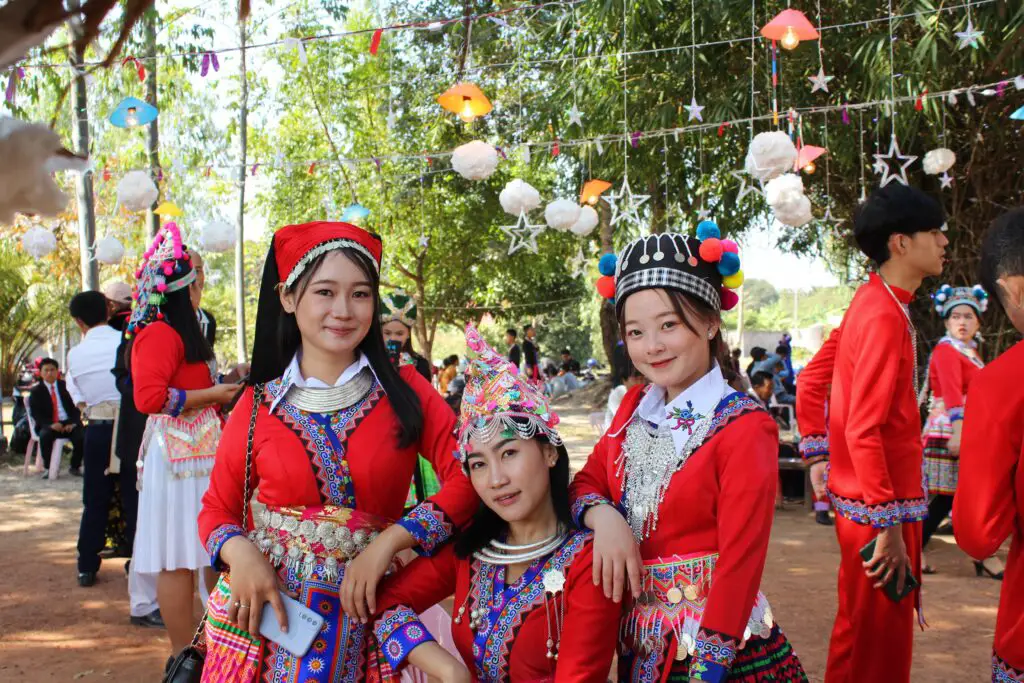
Clothing is one of the most important aspects of any culture. It not only serves as a way to protect us from the elements but also helps to express our identities.
In this blog post, we will be exploring the art of Hmong clothes. Hmong clothing has a long and rich history, and many different types of Hmong clothes can be seen worldwide.
We will also provide some ideas for how you can incorporate Hmong clothes into your own wardrobe!
Hmong clothes history
The history of Hmong clothes stretches back centuries, and its origins are believed to have begun in southern China, later moving to other parts, including Vietnam.
The Hmong people are an ethnic minority that was originally nomadic, living across many different regions throughout Asia.
They developed a unique clothing style inspired by their environment, using natural materials such as hemp, cotton, and silk.
Hmong clothing is intricately detailed and unique, often involving intricate embroidery and colorful patterns.
Types of Hmong outfits
There are many different types of Hmong clothes that can be seen throughout the world. One type of traditional Hmong outfit is the paj ntaub, which consists of a sleeveless shirt and a skirt or trousers.
This type of clothing is typically brightly colored and often features intricate embroidery throughout.
Another type of traditional Hmong outfit is the hu plig, which consists of a hooded top with long sleeves and pants. These outfits are usually darker in color and often feature hand-embroidered embellishments.
Hmong clothes can also be seen in modern fashion, with many different types of Hmong-inspired clothing being produced by designers around the world.
These pieces often feature complex detailing and vibrant colors that draw from traditional Hmong styles.
What are traditional Hmong clothes called?
Traditional Hmong clothes are usually referred to as pa ntaub or hu plig. These terms refer to different types of Hmong clothing that are typically colorful with a lot of detail.
What do Hmong clothes represent?
Hmong clothes represent the culture and history of the Hmong people. Originally made from the hemp plant, the Hmong people believe that Hmong dresses are worn in the spirit world to meet their predecessors in the afterlife.
What do the coins in Hmong clothes represent?
The coins in Hmong clothes are usually symbolic of wealth and good luck. They are often seen as a sign of prosperity and can also be used to ward off evil spirits.
The coins are often sewn onto the fabric of the Hmong clothes and serve as a reminder to be thankful for the blessings one has received.
Cultural significance of Hmong clothes

Hmong clothes are more than just a form of fashion. They are deeply rooted in Hmong culture that spans vast Asian territories.
Hmong clothing is often seen as an expression of identity and pride, and it has also been used to express feelings of love, sorrow, and joy.
Clothing can be a powerful way to honor the past and celebrate heritage, which is why Hmong clothes continue to be an important part of Hmong culture today.
How are traditional Hmong clothes made?
Hmong clothes are traditionally made by hand, and the process involves a lot of elaborate detail. To begin, materials such as hemp, cotton, and silk are woven together to create the fabric for the clothing.
Next, designs are embroidered onto the fabric using vividly colored threads. Finally, each piece is expertly tailored to fit the wearer.
Difference between Chinese and Vietnamese Hmong outfits
There are many similarities between Chinese and Vietnamese Hmong outfits, but there are also some notable differences.
The most obvious difference is in the color palette. Chinese Hmong clothes tend to feature brighter colors, while Vietnamese Hmong clothes often have more subdued tones.
Additionally, Chinese Hmong outfits often have more intricate embroidery and detailing, whereas Vietnamese Hmong clothes are typically simpler and more direct.
Finally, Chinese Hmong garments often feature longer sleeves and hemlines than their Vietnamese counterparts.
Hmong clothes ideas
If you are looking to add some Hmong-inspired pieces to your wardrobe, there are many different ideas that you can use.
You can take inspiration from traditional Hmong clothing and add modern touches such as beads or other embellishments. Or, you could go for a more contemporary look and incorporate modern fabrics and silhouettes.
For a unique and stylish look, try pairing a Hmong top with jeans or trousers. You can also find traditional pieces such as the paj ntaub or hu plig to add an ethnic touch to your outfits.
Opt for bright colors and sophisticated needlework if you want to make a statement. For an even bolder look, try pairing a Hmong outfit with modern items like sneakers or jackets.
No matter how you choose to wear your Hmong clothes, they will always be a beautiful and unique way to express yourself!
With the right pieces and styling ideas, you can create a truly one-of-a-kind look.
Conclusion
Hmong clothes are a beautiful and unique form of traditional art. They tell the story of the Hmong people and are a way to express one’s identity while celebrating their cultural heritage.
Through this blog post, we have explored the history and meaning of Hmong clothes and some of the different types that exist.
We have also provided some ideas for how you can incorporate Hmong clothes into your own wardrobe.
Whether you are looking to celebrate your Hmong heritage or add some unique style to your wardrobe, Hmong clothes can be a great addition. Thanks for reading!
